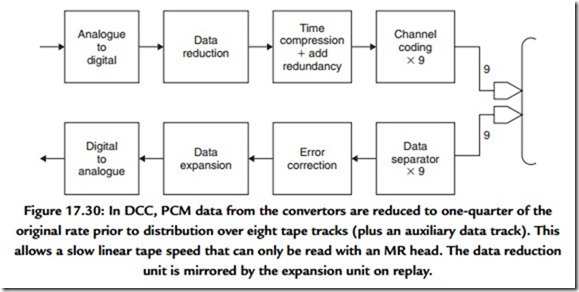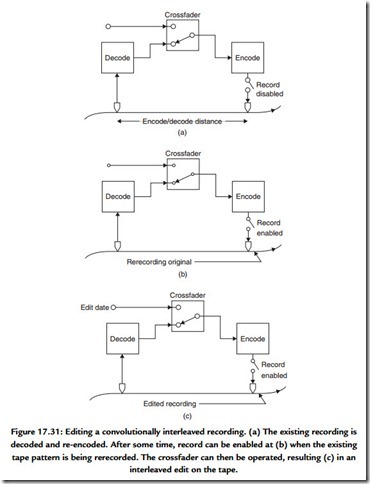Editing Digital Audio Tape
Digital recordings are simply data files, and editing digital audio should be performed in the same way that a word processor edits text. No word processor attempts to edit on the
medium, but brings blocks of data to a computer memory where it is edited before being sent back for storage.
In fact, this is the only way that digital audio recordings can be edited because of the use of interleave and error correction.
Interleave reorders the samples on the medium, and so it is not possible to find a physical location on the medium that corresponds linearly to the time through the recording. Error correction relies on blocks of samples being coded together. If part of a block is changed, the coding will no longer operate.
Figure 17.31 shows how an audio edit is performed. Samples are played back, deinterleaved, and errors are corrected. Samples are now available in their natural real-time sequence and can be sent to a cross-fader where external material can be inserted. The edited samples are then recoded and interleaved before they can be rerecorded. Deinterleave and interleave cause delay, and by the time these processes have been performed, the tape will have moved further through the machine. In simple machines, the tape will have to be reversed, and new data recorded in a second pass. In more sophisticated machines, an edit can be made in a single pass because additional record heads are placed further down the tape path.
In a stationary head machine, these are physically displaced along the head block. In a rotary head machine, the extra heads are displaced along the axis of the drum.
Displaced heads also allow synchronous recording to be performed on multitrack digital audio recorders.
Some stationary head digital formats allow editing by tape cutting. This requires use of an odd-even sample shift and concealment to prevent the damaged area of the tape being audible. With electronic editing, now widely available, tape-cut editing is obsolete as it does not offer the ability to preview or trim the result and causes damage to the medium. The glue on the splicing tape tends to migrate in storage and cause errors.

